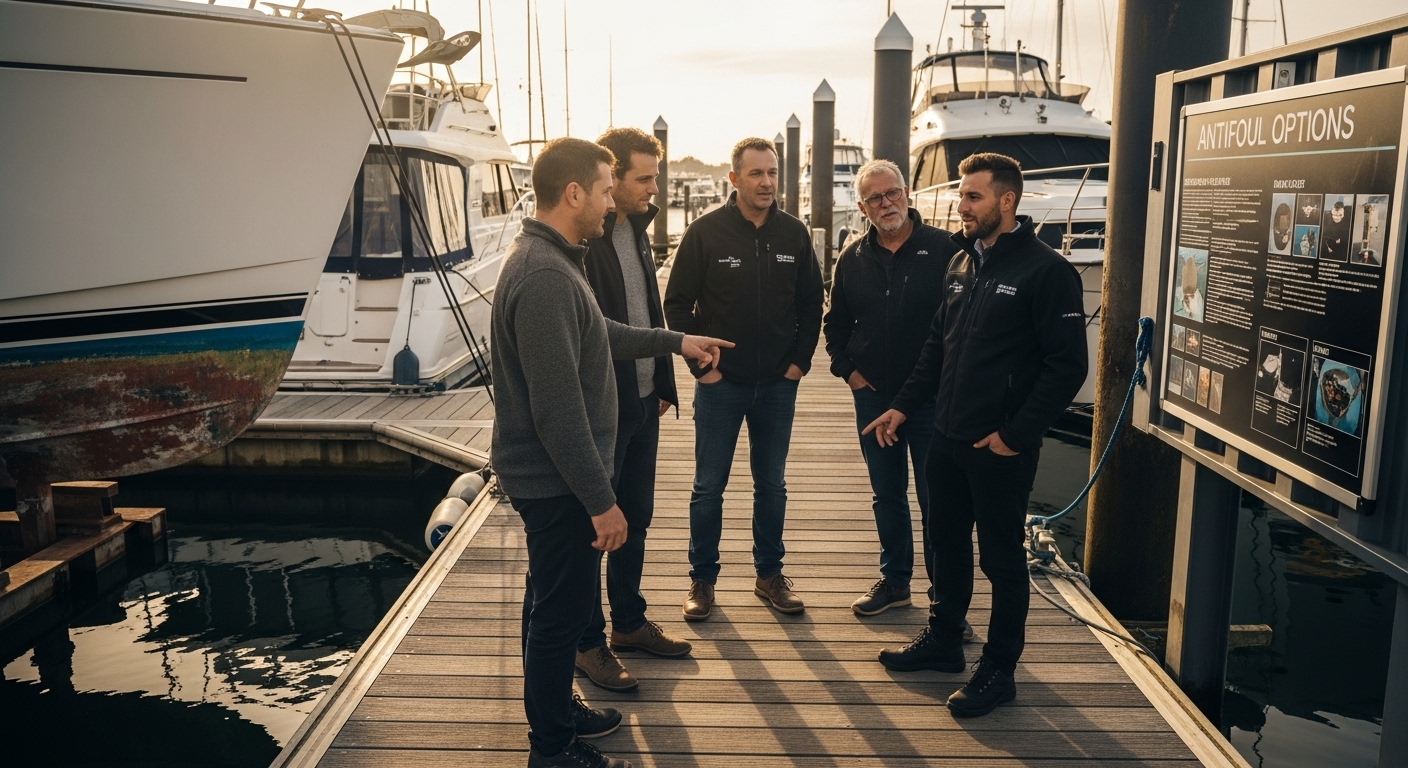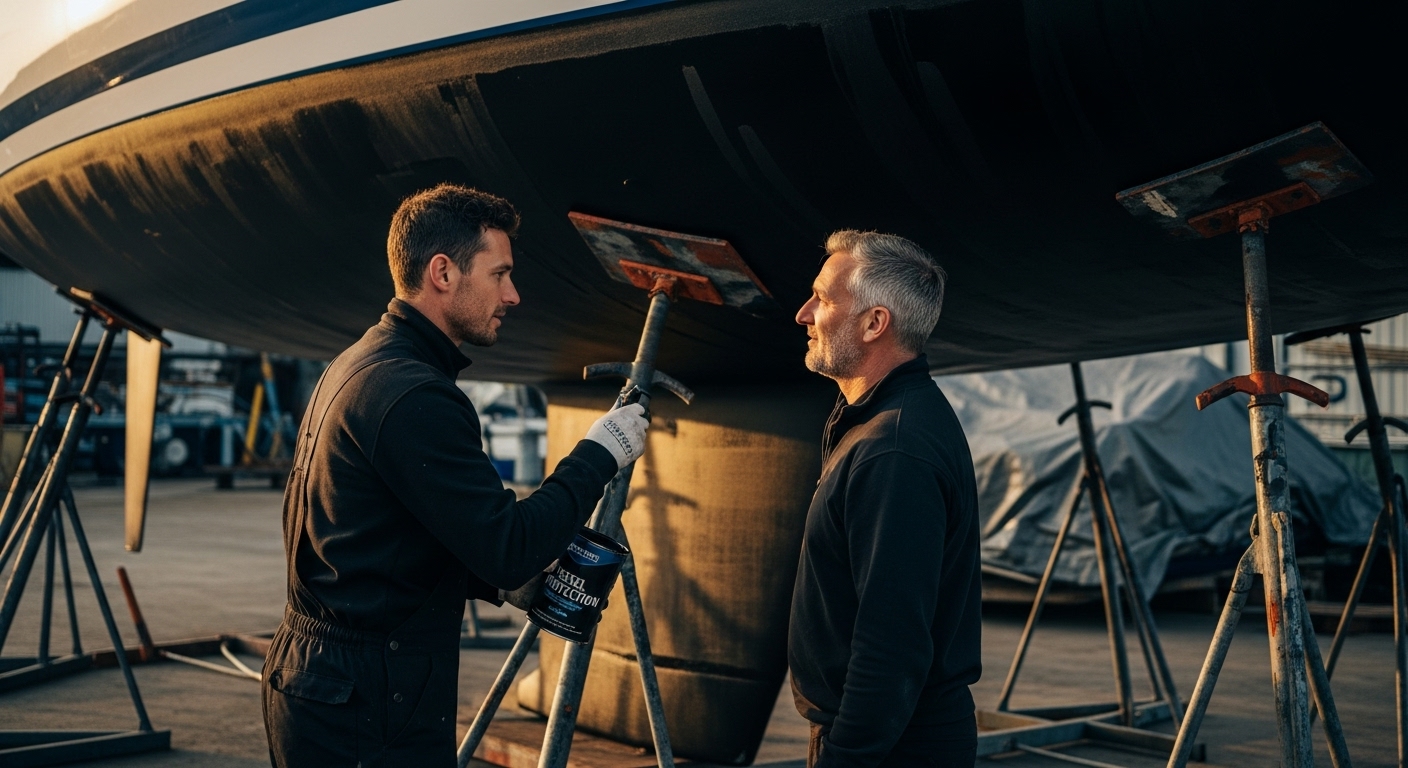Understanding Antifoul Options for Boat Owners
- andy80165
- Sep 17
- 8 min read

Marine growth can quietly destroy both the speed and the fuel savings of any boat. Think a thin film of slime is harmless? Studies show even a small layer of marine buildup can spike fuel consumption by up to 40 percent, draining wallets fast. Many owners think antifouling is a once-a-year hassle, but it’s actually at the heart of smarter and cleaner boating.
Table of Contents
Quick Summary
What is Antifouling and How Does It Work?
Antifouling represents a critical marine protection strategy designed to prevent unwanted biological growth on boat hulls and underwater surfaces. This specialized protective technique addresses the persistent challenge of marine organisms attaching and proliferating on vessels, which can significantly impact performance, fuel efficiency, and overall maritime equipment functionality.
The Science Behind Marine Organism Attachment
Marine organisms like algae, barnacles, and various microscopic creatures naturally seek stable surfaces to colonize. Boat hulls provide an ideal environment for these organisms, creating what scientists call a biofouling ecosystem. When left untreated, these biological attachments can dramatically increase water resistance, reduce vessel speed, and cause substantial damage to the boat’s structural integrity.
According to Australian Department of Infrastructure, effective antifouling involves specialized coating technologies that create an inhospitable environment for marine organisms. These advanced coatings typically contain specific chemical compounds that:
Prevent organism attachment
Disrupt biological growth mechanisms
Provide a smooth, toxic surface that deters marine life
How Antifouling Coatings Operate
Modern antifouling solutions work through sophisticated chemical interactions. The coating releases controlled amounts of biocidal compounds that make the boat’s surface physiologically challenging for marine organisms. These compounds interrupt the attachment and settlement processes, essentially creating a microscopic defensive barrier that protects the vessel’s underwater surfaces.
Boat owners must understand that antifouling is not a one-time application but a continuous protection strategy. Regular inspection, maintenance, and strategic reapplication ensure ongoing vessel performance and longevity. The right antifouling approach can significantly reduce maintenance costs, improve fuel efficiency, and extend the operational life of marine vessels.
Why Antifouling is Essential for Boat Maintenance
Boat maintenance involves multiple strategies, but antifouling stands out as a critical protection mechanism that directly impacts vessel performance, economic efficiency, and environmental sustainability. Without proper antifouling treatments, boats become vulnerable to complex marine biological challenges that can dramatically reduce their operational effectiveness.
Economic and Performance Implications
The accumulation of marine organisms on boat hulls creates substantial economic consequences. Biological growth increases water resistance, which means engines must work harder to maintain speed, leading to significantly higher fuel consumption. Research suggests that even a thin layer of marine growth can increase fuel consumption by up to 40%, representing a substantial financial burden for boat owners.
According to Australian Department of Agriculture, Fisheries and Forestry, regular antifouling maintenance provides critical benefits including:
Reduced fuel consumption
Enhanced vessel speed and maneuverability
Prevention of long-term structural damage
Minimized risk of marine pest transmission
Environmental and Structural Protection
Beyond economic considerations, antifouling plays a pivotal role in environmental protection. Marine organisms can introduce invasive species into new ecosystems, potentially disrupting delicate marine environments. Moreover, unchecked biological growth can cause physical damage to boat hulls, leading to corrosion, material degradation, and potentially expensive repair requirements.
Boat owners must recognize antifouling as an ongoing maintenance strategy, not a one-time solution. Regular inspections, strategic coating applications, and understanding the specific marine environments where vessels operate are essential for comprehensive boat protection. Investing in quality antifouling treatments represents a proactive approach to preserving vessel performance, reducing long-term maintenance costs, and supporting responsible maritime practices.
Types of Antifoul Options Available
Antifouling technologies have evolved significantly, offering boat owners a range of sophisticated solutions to protect marine vessels from biological growth. Each antifoul option presents unique characteristics, performance capabilities, and environmental considerations that boat owners must carefully evaluate.
Biocidal Copper-Based Antifouling Coatings
Copper-based antifouling paints represent the most traditional and widely used marine protection method. These coatings release copper compounds that create a toxic environment for marine organisms, effectively preventing their attachment to boat surfaces. While highly effective, these solutions require careful application and periodic recoating to maintain optimal performance.
According to Australian Department of Agriculture, Fisheries and Forestry, boat owners should consider the following when selecting copper-based antifoul options:
Compatibility with vessel material
Expected marine environment exposure
Frequency of vessel usage
Environmental regulations and restrictions
Alternative and Eco-Friendly Antifouling Technologies
Emerging antifouling technologies provide more environmentally conscious alternatives to traditional copper-based solutions. Silicon-based and Teflon-based coatings offer innovative approaches to marine surface protection. These advanced technologies create smooth, slippery surfaces that make it challenging for marine organisms to establish attachment, reducing biological growth without releasing toxic compounds.
Modern antifouling options also include non-toxic mechanical barriers and hybrid coating systems that combine multiple protective mechanisms. These sophisticated solutions aim to provide comprehensive boat protection while minimizing environmental impact. Boat owners now have access to a diverse range of antifouling technologies that balance performance, durability, and ecological responsibility.
Below is a comparison table summarizing the main types of antifouling options discussed, highlighting their characteristics, performance, and environmental considerations.

Environmental Impact of Antifoul Products
Antifoul products represent a complex intersection between marine technological protection and environmental conservation. While these coatings are essential for maintaining vessel performance, they simultaneously pose potential ecological risks that demand careful consideration and responsible management.
Chemical Composition and Marine Ecosystem Interactions
Toxic biocidal compounds in traditional antifoul products can create significant environmental challenges. These chemical components, designed to prevent marine organism attachment, can inadvertently cause broader ecosystem disruption. Copper and metallic compounds commonly found in antifoul treatments can accumulate in marine sediments, potentially harming aquatic life and disrupting delicate marine biological systems.
According to Australian Government Maritime Regulations, boat owners and marine operators must consider several critical environmental factors:
Potential toxicity of coating ingredients
Long-term accumulation of chemical residues
Impact on marine biodiversity
Compliance with environmental protection standards
Sustainable Antifouling Strategies
Recognizing the environmental challenges, marine technology developers are increasingly focusing on creating eco-friendly antifoul solutions. These innovative approaches prioritize minimizing chemical leaching while maintaining effective biological growth prevention. Emerging technologies include silicon-based coatings, non-toxic mechanical barriers, and biologically inspired surface treatments that reduce environmental contamination.
Responsible boat owners must adopt a holistic approach to marine maintenance. This involves selecting environmentally conscious antifoul products, implementing careful application techniques, and supporting ongoing research into sustainable marine protection technologies. By understanding the complex relationship between vessel maintenance and ecological preservation, maritime communities can develop more responsible and environmentally sensitive practices.
Choosing the Right Antifoul for Your Needs
Selecting an appropriate antifouling solution involves a nuanced understanding of vessel characteristics, environmental conditions, and specific performance requirements. Boat owners must approach this decision strategically, considering multiple factors that influence the effectiveness and longevity of marine protective coatings.
Vessel-Specific Considerations
Boat material and usage patterns play a critical role in determining the most suitable antifoul product. Different vessel constructions respond uniquely to various coating technologies, making a one-size-fits-all approach ineffective. Fiberglass, aluminum, and wooden boats each present distinct surface characteristics that require tailored antifouling strategies.
According to Australian Department of Agriculture, Fisheries and Forestry, boat owners should evaluate the following key selection criteria:
Vessel construction material
Typical marine environment
Frequency and intensity of boat usage
Budget for maintenance and reapplication
Local environmental regulations
Performance and Environmental Compatibility
Modern antifouling technologies offer a spectrum of performance characteristics. High-performance coatings provide extended protection periods, reduced fuel consumption, and minimal environmental impact. Boat owners must balance technical performance with ecological responsibility, selecting products that offer optimal protection while minimizing marine ecosystem disruption.
Advanced selection involves understanding the specific marine environments where vessels operate. Coastal waters, tropical regions, and freshwater locations present unique biological challenges that require specialized antifouling approaches. Professional marine consultations can provide valuable insights into selecting the most appropriate protective coating for specific boating contexts.

Protect Your Investment With Advanced Antifoul Solutions
Tired of fighting stubborn marine growth, rising fuel costs, or constant hull maintenance? As explained in this article, the right antifouling approach is the key to maintaining your boat’s speed, safety, and value. The pain of increased drag, biofouling damage, or costly repairs can be avoided. At Lightning Boat Builders, we specialize in mobile marine services tailored to your needs, including professional antifoul applications that keep your vessel performing at its highest level. We make it easier to protect your boat and extend its life with expert solutions you can trust.

Ready to take the stress out of antifoul maintenance and see real results? Visit our mobile marine antifoul and detailing specialists to schedule your service now. Secure the ultimate protection for your hull and enjoy smoother boating by contacting us today.
Frequently Asked Questions
What is antifouling and why is it important for boat maintenance?
Antifouling is a marine protection strategy designed to prevent unwanted biological growth on boat hulls and underwater surfaces. It’s crucial for maintaining vessel performance, fuel efficiency, and preventing structural damage caused by marine organisms.
How do antifouling coatings work to protect boats?
Antifouling coatings release controlled amounts of biocidal compounds, creating an inhospitable environment for marine organisms. This disrupts their attachment processes, preventing biological growth and protecting the vessel’s surfaces.
What are the different types of antifoul options available for boat owners?
Boat owners can choose from several antifoul options, including biocidal copper-based coatings, eco-friendly silicon-based and Teflon-based solutions, mechanical barriers, and hybrid coating systems that offer various levels of protection and environmental consideration.
How can I select the right antifoul product for my boat?
Selecting the right antifoul product involves considering factors such as your boat’s material, typical marine environment, frequency of use, and any local environmental regulations. It’s important to evaluate the performance characteristics of different coatings and their compatibility with your specific boating needs.
Comments